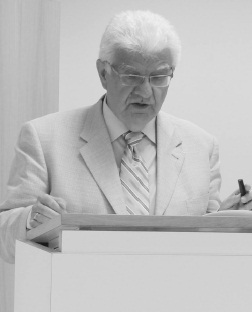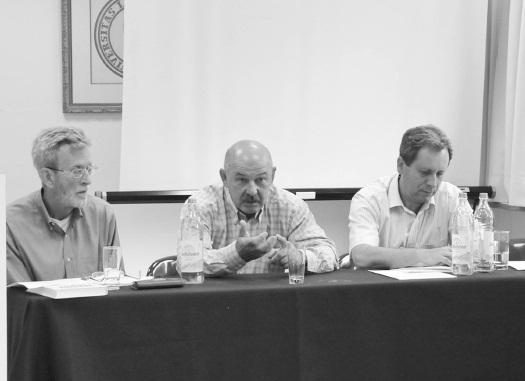Conference
about Ukraine on the Historiographic Map of Interwar Europe
 An
international conference, “Ukraine on the Historiographic Map of
Interwar Europe,” was held [July 1-3, 2012] at the premises of the
Ukrainian Free University (UFU) in Munich. It was organized
collaboratively by the W.K. Lypynsky East European Research Institute
(Philadelphia), Peter Jacyk Centre for Ukrainian Historical Research
(Canadian Institute of Ukrainian Studies, University of Alberta),
Harvard Ukrainian Research Institute, Institute of History of Ukraine
at the National Academy of Sciences of Ukraine, and by the Department
of History of Eastern- and Southern-Eastern Europe at the Historical
Seminar (Ludwig Maximilian University in Munich).
An
international conference, “Ukraine on the Historiographic Map of
Interwar Europe,” was held [July 1-3, 2012] at the premises of the
Ukrainian Free University (UFU) in Munich. It was organized
collaboratively by the W.K. Lypynsky East European Research Institute
(Philadelphia), Peter Jacyk Centre for Ukrainian Historical Research
(Canadian Institute of Ukrainian Studies, University of Alberta),
Harvard Ukrainian Research Institute, Institute of History of Ukraine
at the National Academy of Sciences of Ukraine, and by the Department
of History of Eastern- and Southern-Eastern Europe at the Historical
Seminar (Ludwig Maximilian University in Munich).
Founded
in Vienna in 1921, the UFU was soon transferred to Prague and in 1945
to Munich. In the Interwar Period, it was not only a higher
institution for migr Ukrainian youth, but also one of the leading
institutions for researching Ukrainian History in Europe. Not
surprisingly, the interwar historiographic legacy of the UFU and its
professors was often addressed at the conference.
Six
panels were held at the conference. On 1 July, the thematic direction
of the conference was defined by Professor Andreas Kappeler in his
introductory lecture, “What is Ukraine? What is Europe? What is a
Historiographic Map?”, in which he formulated a number of important
questions. What territories should be included in Interwar Europe?
Who could be considered a Ukrainian historian? Who were immigrants
from Ukraine? Where was research in Ukrainian Studies conducted? What
were the connections with non-Ukrainian scholars? Prof. Kappeler paid
special attention to the content of historical research during the
Interwar Period, provoking the following questions: what are
considered to be Ukrainian Studies? What historical schools were
involved in the emigration? How did the historiographic situation in
the new countries of settlement impact their research? Were they
under the influence of Soviet Historiography? What specific topics
were elaborated by migr historians? How did the political situation
in Interwar Europe influence the historiographic process? Prof.
Kappeler’s closing remarks were that the answers to these and many
other questions would help define Ukraine’s place on the map of
Europe.
 On
2 July, Mark von Hagen opened the panel, “Revising the Revolution,”
with his presentation “Pavlo Khrystiuk: An Attempt at Postcolonial
Revision of his History of the Ukrainian Revolution,” in which he
spoke on Khrystiuk’s fate, his return to the Soviet Ukraine and his
concept of history of the Ukrainian Revolution. In his presentation,
“Reflections of Interwar Ukrainian Emigr Historiography on the
Failure of the National Revolution,” Prof. Vladyslav Verstiuk
focused mainly on the vision of the Ukrainian Revolution by Mykhailo
Hrushevsky, Volodymyr Vynnychenko, and Viacheslav Lypynsky, whose
concepts and thoughts were used not only in the academic polemics,
but also in the political struggle between various groups in
emigration, and were later revived in independent Ukraine. This idea
of historical work as an instrument in political struggle was
elaborated by Oleh Pavlyshyn in his presentation, “The ‘United
Ukraine’ Idea in the Discourse of Emigr Historiography of the
Ukrainian Revolution,” who pointed out the engagement of various
authors in historical events.
On
2 July, Mark von Hagen opened the panel, “Revising the Revolution,”
with his presentation “Pavlo Khrystiuk: An Attempt at Postcolonial
Revision of his History of the Ukrainian Revolution,” in which he
spoke on Khrystiuk’s fate, his return to the Soviet Ukraine and his
concept of history of the Ukrainian Revolution. In his presentation,
“Reflections of Interwar Ukrainian Emigr Historiography on the
Failure of the National Revolution,” Prof. Vladyslav Verstiuk
focused mainly on the vision of the Ukrainian Revolution by Mykhailo
Hrushevsky, Volodymyr Vynnychenko, and Viacheslav Lypynsky, whose
concepts and thoughts were used not only in the academic polemics,
but also in the political struggle between various groups in
emigration, and were later revived in independent Ukraine. This idea
of historical work as an instrument in political struggle was
elaborated by Oleh Pavlyshyn in his presentation, “The ‘United
Ukraine’ Idea in the Discourse of Emigr Historiography of the
Ukrainian Revolution,” who pointed out the engagement of various
authors in historical events.
Prof.
Zenon Kohut opened the next panel, “Historians of the State
School,” with his presentation “Habent sua fata libelli: Petro
Doroshenko’s Biography in Dmytro Doroshenko’s Account,” in
which he discussed the fate of Dmytro Doroshenko’s manuscript on
his prominent ancestor and the circumstances in which it was
discovered and published in 1985. The presenter also made a
comparative analysis with a monograph on Petro Doroshenko by the
Polish scholar Jan Perdenia, which had been similarly published many
years after the author’s death. In his presentation, “Hrushevsky
and Lypynsky in Historical Debates”, Prof. Frank Sysyn spoke on the
controversial attitudes of these two prominent Ukrainian historians
regarding the Khmelnytsky era, emphasizing the impact of Lypynsky’s
book Ukraina na perelomi [Ukraine at Crossroads] on Ukrainian
historical thought and political discourse. The presenter noted that
Lypynsky is usually considered as an historian of the statist school,
while his treatment of a nation and people was underestimated, as
well as his attempt to undermine the traditional Polish historical
scheme.
Vadym
Adadurov opened the third panel, “People and Institutions of
Central- and West-European Emigration,” with his presentation “The
Construction of a Mythological Image of Ukraine in France in the
17-19th Centuries by Ilko Borshchak.” After a thorough discussion
of archival sources, the researcher discovered various falsifications
employed by Borshchak, which, unfortunately, were absorbed into
modern Ukrainian historiography. In his presentation, “The Life and
Work of Stepan Rudnytsky in Vienna and Prague in 1921-1926,” Prof.
Guido Hausmann spoke about the migr activities of this well-known
geographer in the context of European scholarship. He concluded that
the fact that the German and Austrian academic milieu ignored
Rudnytsky, might have caused his return to Soviet Ukraine. Tetiana
Boriak’s presentation, “The Ukrainian Historical Cabinet and the
Phenomenon of the Prague Archive,” dealt with works by Arkadii
Zhyvotko and the Ukrainian Historical Cabinet, which he directed. In
his presentation, “The Ukrainian Research Institute in Berlin and
History as a Science,” Prof. Nicolas Szafowal analyzed the
activities of this migr institution focusing on its historical works.
He noted that in the Interwar Period, academic institutions were
frequently favourable to political organizations and movements: the
Institute was under the influence of the conservative monarchist
ideology.
On
3 July, Prof. Leonid Zashkilniak opened the next panel, “In the
Homeland and in Emigration: Ukrainian Historiography in Interwar
Poland.” In his presentation, “Ways of Legitimization of the
National History,” he argued that despite ongoing tensions between
Ukrainian politicians, society and the Polish authorities, Ukrainian
historians managed to use their scholarship to contribute to
Ukrainian historical thought. In his presentation, “Writing
Ukrainian History in Emigration. The Diversity of Personal Strategies
in Interwar Poland,” Andrii Portnov spoke about the personal
strategies of migr historians, the possibilities of their “academic
assimilation,” and their career opportunity, which often depended
on their political preferences, non-Ukrainian connections, and topics
of their publications. Prof. Yaroslav Hrytsak’s presentation, “The
Bujak School and its Ukrainian Dimension,” examined the attitude of
Franciszek Bujak to Ukrainians and the Ukrainian question, and
revealed the multinational nature of the School in which the whole
political spectrum of Interwar Poland was represented. Prof. Michael
Moser spoke on “We and Others: History of Ukrainian Literary
Language by Ivan Ohiienko from the Perspective of Discourse
Analysis,” focusing on a thorough language analysis of this popular
work through the prism of creating the images of “us and them.”
At
the panel “The Dialogue Across the Borders,” Oksana Yurkova in
her presentation, “Honouring the Patriarch: A Response to
Hrushevsky’s Death outside Soviet Ukraine,” pointed out the
different levels of honouring the prominent historian, including
obituaries, newspapers, and social events. Prof. Serhii Plokhii’s
presentation, “East and West Together: Ukrainian Historians and the
Outbreak of the Second World War,” was devoted to the cooperation
among scholars, primarily from Galicia and Kyiv, in 1939-1941, which
became possible after “the golden September” of 1939.
The
conference concluded with the round table “Balancing the Ukrainian
Historiography between the Wars.” The participants agreed that many
questions have not been addressed despite the productive discussion
at the conference. They noted that gaps remain on both empirical and
theoretical levels, which encourages them to continue their studies.
The proceedings of the conference will be published soon.
PHOTOS
1-
Prof.
Zenon Kohut
2
- L.
to
R.: Mark
von Hagen, Vladyslav Verstiuk, and Oleh Pavlyshyn at one of the
panels
 An
international conference, “Ukraine on the Historiographic Map of
Interwar Europe,” was held [July 1-3, 2012] at the premises of the
Ukrainian Free University (UFU) in Munich. It was organized
collaboratively by the W.K. Lypynsky East European Research Institute
(Philadelphia), Peter Jacyk Centre for Ukrainian Historical Research
(Canadian Institute of Ukrainian Studies, University of Alberta),
Harvard Ukrainian Research Institute, Institute of History of Ukraine
at the National Academy of Sciences of Ukraine, and by the Department
of History of Eastern- and Southern-Eastern Europe at the Historical
Seminar (Ludwig Maximilian University in Munich).
An
international conference, “Ukraine on the Historiographic Map of
Interwar Europe,” was held [July 1-3, 2012] at the premises of the
Ukrainian Free University (UFU) in Munich. It was organized
collaboratively by the W.K. Lypynsky East European Research Institute
(Philadelphia), Peter Jacyk Centre for Ukrainian Historical Research
(Canadian Institute of Ukrainian Studies, University of Alberta),
Harvard Ukrainian Research Institute, Institute of History of Ukraine
at the National Academy of Sciences of Ukraine, and by the Department
of History of Eastern- and Southern-Eastern Europe at the Historical
Seminar (Ludwig Maximilian University in Munich). On
2 July, Mark von Hagen opened the panel, “Revising the Revolution,”
with his presentation “Pavlo Khrystiuk: An Attempt at Postcolonial
Revision of his History of the Ukrainian Revolution,” in which he
spoke on Khrystiuk’s fate, his return to the Soviet Ukraine and his
concept of history of the Ukrainian Revolution. In his presentation,
“Reflections of Interwar Ukrainian Emigr Historiography on the
Failure of the National Revolution,” Prof. Vladyslav Verstiuk
focused mainly on the vision of the Ukrainian Revolution by Mykhailo
Hrushevsky, Volodymyr Vynnychenko, and Viacheslav Lypynsky, whose
concepts and thoughts were used not only in the academic polemics,
but also in the political struggle between various groups in
emigration, and were later revived in independent Ukraine. This idea
of historical work as an instrument in political struggle was
elaborated by Oleh Pavlyshyn in his presentation, “The ‘United
Ukraine’ Idea in the Discourse of Emigr Historiography of the
Ukrainian Revolution,” who pointed out the engagement of various
authors in historical events.
On
2 July, Mark von Hagen opened the panel, “Revising the Revolution,”
with his presentation “Pavlo Khrystiuk: An Attempt at Postcolonial
Revision of his History of the Ukrainian Revolution,” in which he
spoke on Khrystiuk’s fate, his return to the Soviet Ukraine and his
concept of history of the Ukrainian Revolution. In his presentation,
“Reflections of Interwar Ukrainian Emigr Historiography on the
Failure of the National Revolution,” Prof. Vladyslav Verstiuk
focused mainly on the vision of the Ukrainian Revolution by Mykhailo
Hrushevsky, Volodymyr Vynnychenko, and Viacheslav Lypynsky, whose
concepts and thoughts were used not only in the academic polemics,
but also in the political struggle between various groups in
emigration, and were later revived in independent Ukraine. This idea
of historical work as an instrument in political struggle was
elaborated by Oleh Pavlyshyn in his presentation, “The ‘United
Ukraine’ Idea in the Discourse of Emigr Historiography of the
Ukrainian Revolution,” who pointed out the engagement of various
authors in historical events.